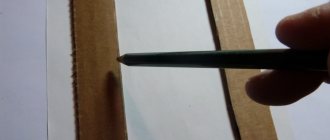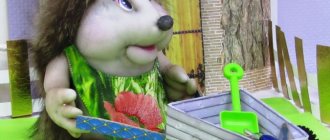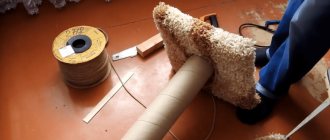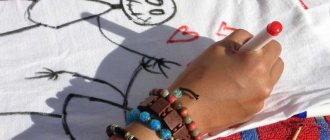If you are a creative person and are not used to a trivial approach to the issue of gift wrapping, then this article will definitely be useful to you. Here we will tell you how to make a paper gift bag yourself at home.
Thanks to such packaging, you will definitely be able to remain in the memory of the hero of the occasion for a long time, and if the package is themed, then you will definitely receive the highest praise.
Here you can learn about the simplest, but most interesting and original types of paper bags and how to make them. Try it, and you will definitely end up with something very interesting and unusual.
How to do
Place a piece of craft paper in front of you and fold the smaller side down one centimeter, then apply a piece of double-sided tape to it. Then you need to fold the paper in half and carefully iron each fold.
Now you need to understand how wide the future paper bag will be. Open a sheet of paper and make folds parallel to the lines on the sides. Now connect by bending the side lines inward.Now you have to design the bottom of the paper bag. To do this, bend the bottom of the future package up so that the strip is equal to the folds on the sides.
Next, you need to bend back the part of the bag that is located at the bottom and fold the sides into the center, thereby forming the corners of your paper bag. Place adhesive tape on the folded sides and seal the bottom of the bag.
To make the bottom of the bag stronger and more durable, cut out a rectangle of suitable size from cardboard and place it inside the bag.
Take a hole punch and use it to make holes in the places where the handles will be. Now it's time for the pre-prepared ribbons. Pass them through the holes you made and secure with small, neat knots.
To ensure that your package turns out beautiful and neat, strictly follow all the instructions and be very careful and scrupulous; only if these conditions are met, the result will please you and not upset you.
Money envelope
At the beginning of the 15th century, Japanese aristocrats introduced the tradition of passing notes folded in a special way to each other. Only the author or the addressee could open them and read them without tearing the paper. This high-society game later developed into the art of gift wrapping, called origata. It was practiced by families of noble samurai as a demonstration of virtuoso mastery of various types of skill. A small gift was placed on a piece of paper and then elegantly wrapped, without ever being moved or turned over. At the same time, by the shape of the envelope, the recipient could determine what was inside - a certain symbolism of the folds was developed.
Origami may have become an extension of the art of origata. It is not difficult to believe this hypothesis when folding Japanese money envelopes. Thanks to handmade work, even the simplest models look elegant and add a special charm to gifts for an anniversary, wedding, birth of a child or graduation. Almost all origami envelopes can be made from A4 sheet.
Option 1
It is advisable to use paper with differently colored sides, velvet or patterned. Thanks to this, the laconic envelope will look decorative.
Step-by-step instruction:
- We start with portrait orientation. Place the sheet with the wrong side up. Fold the left corner to the right edge.
- We lower the top point along the arrow, aligning it with the base of the previous fold.
- Fold the resulting triangle along the dotted line.
- We combine the bottom edge with the top, marking a fold.
- The result is a narrow rectangle.
- Fold the bottom edge along the dotted line. Turn the workpiece over.
- Fold both sides of the envelope towards the middle, slightly overlapping.
- We insert one edge into the other, fixing the envelope so that it does not open.
You can adjust the width of the product, focusing on the size of the gift inside.
A simple origami envelope from A4 is ready.
How to decorate the package
You can use absolutely anything to decorate your paper bag.
It can be beads, sparkles, various beads, pieces of fabric, and in general anything that your imagination tells you. When decorating, you can even use natural materials.
Making a handbag from scraps of wallpaper
Oh, this apartment renovation!
But although famous comedians sang in an equally famous musical fairy tale that “repairs have a beginning, repairs have no end,” let’s still hope that your renovation will one day come to its logical conclusion: new parquet flooring has been laid, new tiles have been laid, new The wallpaper is pasted. And here a reasonable question arises before the happy owner of a renovated living space: where to put the remnants of materials left over from the renovation? After all, you and I are prudent people; as a rule, we buy all materials with a reserve, they say, “you never know!”
And so, despite the fact that all the troubles that could have happened in the apartment during the renovation happened safely, we still had decent remnants of materials - the same wallpaper, for example. Where should I put them? Throw it away?
Maybe someone will take a roll or two of wallpaper to the trash without shuddering, but I, for example, can’t, I just feel sorry for it. I always try to find some kind of “business” for all the material values that suddenly (for various reasons) were left “out of use.”
There are a lot of ideas on the endless expanses of the Internet on how to use leftover wallpaper. And all of them certainly deserve, if not immediate application, then at least attention! I also decided to share my idea with young mothers and no less young grandmothers at the Crafts Fair, how to turn wallpaper scraps into material for joint creativity with a child. I suggest making a gift bag in the form of a handbag from leftover wallpaper.
What is the most valuable thing about my decision to give new life to wallpaper scraps? The fact that you can use even very small scraps!
So, we have the remains of wallpaper left over from the renovation. We also arm ourselves with a ruler, scissors and a fountain pen (or pencil). You will also need a compass, glue and a stapler. I have a good eye and I can do it without a compass, but I will still give instructions using a compass, since everyone’s eye is developed differently. You can use any glue suitable for wallpaper; I had PVA on hand.
What do we get? Very cute gift bags-bags, or just a play bag for your beloved daughter, made by the child himself (or almost independently). Making and decorating such a handbag together with your child will be a great opportunity for joint creativity.
Also, the manufactured bags can be used for quite functional, everyday use. For example, a handbag is good for carrying second shoes for a primary school student, for going to the store with a child for not too heavy purchases, and so on. A creative person will find many ways to use the resulting products. But, of course, I see the main purpose of a bag-bag - to pack gifts in it (for a birthday, for the New Year, but you never know why children might have a reason to give a gift!).
Of course, you can purchase gift packaging. But, you must admit, a thing you made with your own hands cannot be compared with something you bought!
You can make the handbag simple, single-layer. But it seemed to me that if the inside of the handbag is also “beautiful”, then the handbag will look much more aesthetically pleasing. Well, the handle will certainly be stronger. Therefore, I duplicated the pattern with a “lining” and glued the layers together “back to back” using PVA glue.
The main thing in creating a handbag from a piece of wallpaper is to make the correct pattern and bend and fold this pattern correctly. But, however, there is nothing complicated about it, and that’s the beauty of it! Once you understand the structure of the handbag pattern, you can vary its size and shape to your liking.
Step-by-step instruction:
I decide that my handbag will be medium in size, its width at the widest point will be 22 cm, and its height 18 cm. To make a handbag of this size, I will need a piece of wallpaper 41.5 cm long and 30 cm wide, that is, A3 format.
To make a pattern, I take a sheet of A3 format.
I designate the angles with the numbers zero, zero-one, zero-two, zero-three.
I arm myself with a ruler and measure along the long edge from corner O to corner O3 segments of 180, 60 and 180 mm. I get points A and B. Along the second long edge I do the same, I get points A1 and B1. Then I connect the dots found.
On a narrow strip 6 cm wide I build the bottom of our handbag. To do this, I measure 100 mm from points A, A1, B and B1. I get points A2, A3 and B2, B3.
By connecting points A2 and B3, then A3 and B2, with lines, I get the center of the bottom of the bag.
I place the point of the compass at this center, and the pencil of the compass at point A1. But I need a circle with a slightly smaller radius! Therefore, I step back from point A1 by 10 mm and draw a circle.
Then I connect the corners of the bottom of the bag with lines to the corners of the A4 sheet.
I divide the parts of the circle indicated by the dotted line in half and draw lines - these are fold lines.
From points Z, Z1, Z2 and Z3 I retreat 30 mm beyond the edges of the circle and from the resulting points I draw the upper part of the handbag by hand. Then I also draw the handle slot by hand.
Now I show in the photo how you can line up the top part of the handbag using a compass. Find the point Y and Y1 and use a compass to draw 2 arcs.
From points X, X1, X2 and X3 we “curve” to the arcs.
The result is a pattern like this. I will trace the second slotted hole for the handle from the first one when I cut it, so that they are the same.
With a pink felt-tip pen I outlined the part of the pattern that I would use to cut out the “lining” of the handbag.
The pattern is ready, I start cutting out the wallpaper.
I got this blank for a handbag. I pressed it with a heavy ruler, as it tries to curl up into a tube.
The second detail is the “lining”.
I glue the parts together. Please note that the “lining” is not all glued on - the side rectangles are not glued on! The fact that the parts do not quite match is, of course, not very good, but not tragic - the finished product can be carefully adjusted with scissors.
I bend my purse along the fold lines.
I connect the fold twice with a stapler.
On the other side, the same thing: I bend along the fold lines and connect with a stapler.
It turned out like this.
I coat the prepared side part with glue and glue on the “lining” rectangle.
And the final touch - I bend it inward and glue a 10 mm strip of the outer blank.
The second side part of the bag is assembled identically.
I carefully trim the handles of the purse, cutting off the paper where the front and back parts “don’t quite match.”
The result is such a cute little thing. You can decorate it with paper appliqué, pieces of lace or fabric, beads or buttons - there is complete freedom for your imagination! I limited myself to the first letter of my name, cut out of cardboard.
Your little daughter will be delighted with such a handbag, you can be sure! And any child will be proud to present a gift in a beautiful homemade package.
The most important thing is that by making such handbags you can solve two problems at once! The first is to find a worthy use for the “after-repair” wallpaper remnants, and the second is to make a whole batch of very cute packaging bags with your own hands as gifts for all relatives and friends!
I hope that the material I have presented can be useful to someone.
Joy and prosperity to everyone!
Little secrets
If you use thick or cardboard paper in your work, then when bending it is better to go along the line with something sharp, then you will not have cracks or other unpleasant things.
If you are starting to make a paper bag for the first time, it is better if you find the opportunity and time to practice a little. By the way, training can be done using a simple landscape sheet.
This option for making a paper bag is classic and ideal for beginners.
But if you already have sufficient experience in making various crafts, then you will be interested in trying other variations of paper bags.Option 2
It happens that an envelope is needed urgently, and you have to literally fold it on the go. The next model is just for such a case.
Step-by-step instruction:
- Fold the A4 sheet in half horizontally. Let's reveal. Bend the bottom corners towards the middle. We do the same with the right and left sides.
- We raise the bottom point of the triangle to the resulting intersection.
- Using the folds made in the previous step as guides, we open the workpiece from the inside, stretch it to the sides and press it. Thus, we form the lower part of the origami envelope.
- Now we bend the upper corners towards the center. We get the closing flap of the envelope.
When handing it over to the recipient, you can tuck the upper triangle inside or secure it with some kind of decorative seal.
Another envelope, very reminiscent of the previous Japanese origata packaging, is presented in the video tutorial:
Gift bag in the shape of a cone
The original design will be a paper bag in the shape of a cone. This model will add elegance to any small gift. The heroes of the occasion will definitely appreciate it.
To make such a package, roll up beautiful paper, as you used to roll for seeds. Connect the sides with tape and decorate the paper bag according to your discretion and taste.
There are a great variety of options for making paper bags. When making them, use high-quality materials and simply follow simple recommendations.
Also, when decorating, try to ensure that it is thematically suitable for the holiday for which you are going to give a gift in this paper bag.
For example, if it’s an adult man’s anniversary, then flowers, hearts and butterflies are unlikely to suit him. Just like a young girl, brutal presentation of a gift using pistols and other paraphernalia is not suitable.
Let's move on to registration
The created craft bag can be decorated not only with various types of ties on the top, but also with other decorative elements.
You can apply your own design to the surface of the bag. Ink, charcoal, pastel, sepia, and sanguine are best suited for drawing on such a surface. The drawing can be either a solid composition or a set of small elements, as in the photo:
In addition to drawings, you can glue a variety of flat crafts onto paper, both from paper and from fabric, acrylic, etc.
The top of the bag can be left flat or grooved. The design with lace also looks very beautiful, in which you can paste it over a bag, or transfer a lace design to the surface of the paper using paint and a sponge.
Decorations can be made from craft paper using templates for patterns made from plain paper. Such decorations look like this:
You should never neglect natural materials when decorating craft bags: Christmas tree branches, pine cones, acorns on strings go perfectly with the light wood color of the paper.
Photo of a paper bag
Square gift box
What do you need
- Scissors;
- thick paper;
- ruler;
- pencil;
- glue;
- bow.
How to do
Cut out a square measuring 20 × 20 cm from paper. Draw two vertical and two horizontal lines on it, stepping back 5 cm from each edge. In the middle you will get another square.
Use scissors to follow the marked lines and make grooves without cutting through the paper. Bend it along these indentations. Cut along short lines, bend the resulting parts and glue them together as shown in the video.
Cut out a square measuring 16 × 16 cm from paper. Draw two horizontal and vertical lines on it, 3 cm away from the edges. Then cut, bend and glue in exactly the same way as the previous piece. Place the lid on the box and glue a bow on top.
Instead of a regular lid, you can make two triangles that fit completely onto the box:
Hair
To decorate your tilde with two luxurious braids, you will need a skein of knitting thread, floss or wool for felting. Follow the tutorial carefully so that the tilde's hairstyle comes out realistic and neat.
Weave two thick braids with a slight allowance at the top so that they can later be sewn to the head. To allow the braids to be playfully twisted and shaped, weave a piece of wire into the braids during the making process.
The main part of the head will be hidden under the cap, so braids and small bangs are enough for the hair. The braids should be sewn to the head using a basting stitch, and if you are using wool, take a felting needle and beat the wool into the fabric.
You can sew a small cap with your own hands from lace and felt. The headdress should be decorated with ribbon or artificial flowers.
Packaging design for handmade dolls
Among the variety of design options, the following have proven themselves best:
- Box consisting of two parts. The bottom one, where the doll is located, and the lid (with or without a window). Both components are held together with an elegant ribbon or eco-friendly twine with a wax seal, which is fashionable today.
- One piece packaging. When closed, it is very similar to the previous one. However, it consists of just one element, cut out, bent and closed on the side or top. This model is easy to manufacture and practical to use.
There are other varieties, but the main advantage of the two mentioned models is their ease of implementation. Therefore, even a not very experienced craftswoman will be able to carefully make such a box for a doll with her own hands without any problems.
Pyramid gift box
What do you need
- Scissors;
- thick paper;
- ruler;
- pencil;
- plate or disk;
- hole puncher;
- yarn or ribbon.
How to do
Cut out a square from paper. Using four lines, divide it into nine parts. Make a mark in the center of each side of the large square. Inside the squares adjacent to the marks, draw triangles as shown in the video.
Place a plate or disk on the sides of the triangle and trace. Cut out the shape along the marked lines. You should end up with something like a flower.
Bend the figure along all straight lines and connect the pyramid. Make holes in the tops of the triangles, thread yarn or ribbon through and tie.
Such a pyramid can also be made using the origami technique:
Tools
In addition to ordinary scissors, you can use a shaped device (zigzag, wave) to decorate a doll box.
If there is no specialized tool for scoring, it is done under a ruler using a nail file or a disposable plastic knife.
As for adhesive materials, it is better to choose one that dries quickly and is easy to work with. A glue gun is rarely used to make a doll box with your own hands. Traces may remain from it. And it’s not always possible to apply it in an even, thin layer. Most people prefer a combination of PVA or Moment and double-sided tape. It is worth remembering that the latter may come off over time. Therefore, you should not use it to connect component elements.
If the box-box consists of several parts (with further gluing), it is better to use brown masking tape to hold them together.
Ordinary clothespins will be indispensable when making a doll box with your own hands. They are used to fix parts while the glue dries. They must be clean, dry and not leave marks.
Gift box with flip lid
What do you need
- Ruler;
- pencil;
- thick paper;
- scissors;
- glue.
How to do
Draw two lines on the two narrow sides of the sheet at a distance of 1.5–2 cm from the edge and fold the paper along these lines. Bend and straighten the sheet as shown in the video. You will get two folds in the middle.
Draw lines on the long sides of the sheet at the same distance. For clarity, draw the bends made in the middle. Make cuts down to long horizontal lines. Glue the paper together as shown in the video.
The hinged lid can be made from a separate sheet:
Goose bag
To make a goose with your own hands you will need:
Description
We mark on the fabric the details of the head (with a neck, but without a beak) and wings of the packet doll according to life-size patterns.
Cut out the marked parts with allowances. For the beak we prepare a small piece of fabric.
We attach it to the cut of the head and iron the seam.
We fix the seams at two points with pins and outline the contours of the beak. We sew it according to the markings.
We trim the allowances on the pattern lines with curly scissors. We assemble the blanks for paws and wings in pairs.
We turn the wings and paws completely inside out. We turn the neck partially out to make it easier to fill it with filler.
We sew off the ends of the wings and paws to approximately half the length along the front side.
We fill the head and neck with filler, gradually turning the part inside out. Place the filler tightly into the paws. We partially fill the wings with filler, only in the lower zone of the feathers.
For the bag bag, cut out a strip of 50 by 95 cm. Cut it in half into two almost squares.
We place the paws along the axis of the future bag and pin them.
We sew the blanks along one side and the bottom edge, while simultaneously attaching the legs.
We turn the upper sections to the wrong side by 40 mm.
We make one line along the edge of the hem, then a second - after 1 cm. The result is a drawstring for the elastic.
We sew together the second side of the bag. With one line we reach the drawstring from below, the second - from above, leaving the entrance to the drawstring open.
We fold the lower corners of the bag into a triangle with a center line along the seam, pin it and sew it with a perpendicular stitch.
Money in an envelope: original ideas
The envelope design allows you to place the money inside in different ways.
.
Here are some ideas to help you make original envelopes. For example, you can use a postcard
, inside which you paste a small envelope with money.
You can write wishes on the card, and when you look inside, the recipient will find a cash gift
.
Another option is to make the envelope also in the form of a postcard, and attach satin ribbons inside that will hold the bills
.
Book of envelopes
. This original idea will appeal to those who would like to learn how to save money. You can make some simple envelopes and sign them, indicating the purpose for which the money is stored in them and the time when it can be spent.
Step-by-step execution of the craft
After preparing all the materials, you need to lay out the patterns on the fabric. It is convenient to fix the paper parts on the canvas using pins. The details are outlined with chalk or a piece of soap. Then remove the patterns and cut the fabric. To simplify the work, you can not outline the workpieces, but immediately cut out the parts .
Now you need to move on to stitching the parts. First, it is recommended to sew the doll itself. Decorate the head, body and arms.
After this, it's time to start sewing on the eyes. Special plastic elements are used as eyes. They can also be made soft, for example, cut out of felt. They also sew on small buttons. The mouth is usually embroidered with thread. You can decorate the hands with fingers. Simply separate them with thin threads and pull them together a little.
It is better to watch the design of the face step by step in video instructions on various sites. You can draw eyes and a mouth on the bag with your own hands. Master classes and descriptions will help novice craftswomen stock up on ideas.
When half of the pupa is ready, you can proceed to assembling the lower part.
To do this, you need to cut out two parts:
To save material, the storage bag is made from tights. It is enough to cut them correctly, sew them on one side, and sew them under the skirt with the same side. On the other hand, you need to make a drawstring and insert an elastic band into it. To prevent the bags from falling out, you need to tighten the rubber band quite tightly.
But you can sew the bag yourself; the do-it-yourself bag maker doll master class includes this element. You need to cut out a rectangular element from the fabric. The width should be equal to the length of the skirt. The length of the segment must be selected depending on the volume of the overskirt. Now the part is folded in half and stitched along one side. The result should be a pipe. One end of the pipe must be sewn into the place where the skirt is attached. But on the second side you need to make a hem of 2 centimeters. An elastic band is subsequently inserted into it.
Now the bag doll is ready!
How to make packaging for a doll in 10 minutes
I want to tell you and show you how quickly, in 10 minutes, you can assemble a doll for the road.
I am posting my master class to help beginners, maybe someone will find it useful. When I first started making dolls, I kept stumbling over the problem of how to send them. Having tried many packages, complex and simple, expensive and cheap, I came to two conclusions.
1. Durable, beautiful industrial packaging costs money. Naturally, this price will need to be included in the cost of the products. Naturally, I don’t want to do this, because then the cost of my dolls will increase by 10 percent. In the current economic reality, such moves can upset the price-quality balance, but I don’t need that. That’s why I gave up expensive packaging and haven’t bought it for a long time.
2. You can make exclusive packaging with your own hands, as some craftsmen do. I respect them very much for this and look at them with sacred horror. In my case - no, no and no! I am absolutely not ready to spend 3 hours creating such a hand-made masterpiece. I feel even more sorry for the time than for the money in point 1.
Packaging is still needed, there’s no way around it, I can’t wrap the doll in newspapers or rags when sending it and ruin the whole impression for the buyer. Therefore, I presented only one requirement for the container I needed, but the main requirement was strength. I found everything I needed in an industrial area of the city at an enterprise that produces self-assembled boxes in bulk, in small wholesale, and in general, one at a time. As a result, I now have cardboard cutouts in three sizes: for the smallest parcels, for sets and for finished dolls. I buy these cuttings in small wholesale, the price for such packaging is from 14 to 40 rubles per piece. Almost for nothing, and I suspect that if you buy cardboard in a store and glue the box yourself, its cost will be higher. And also draw, cut, glue. In general, it’s easier and cheaper to buy a ready-made construction kit. I really wanted black boxes, but they can only be ordered in large quantities, I can’t make that many dolls in a year, and I didn’t like the white boxes. Therefore, I settled on gray-brown, the color of kraft paper. The wall thickness is 3 mm, which is very pleasing.
It’s also very nice that such a box can be decorated in any way you like. Due to lack of time, I am not particularly zealous in this direction. Although I need to finally order a stamp and think about the external design of the packaging, at the moment I am operating under the motto “fast, durable, aesthetically pleasing.” The packaging performs its function well and delivers the dolls intact. So far the whole process is going like this and I needed:
- cardboard cut-out box;
— paper for labels (adhesive);
— filler (sesal, wood shavings or any other);
- ruler, pencil, cutter, scissors.
First, I print a picture on sticky paper to stick on the box. Well, at the same time, labels, so there’s no wasted space.
Then I assemble the box, and from a roll of kraft paper I cut out a rectangle to fit the bottom of the box with long edges that will then overlap. I coat the bottom of the box with glue.
And I glue the paper to the bottom, the edges of the paper stick out freely.
Then, on the back of the box in the middle, I mark two lines equal in width to the width of the satin ribbon.
I cut these lines with a cutter and insert the ends of the tape into the holes.
From the outside and inside it looks like this:
Now it's time for the doll. I put it in a box and tie a bow. The bow is only delicate in appearance, it is tied very tightly and covers the doll’s arms, which are pressed tightly to the sides. At first, in my experiments, I tried to tie the arms and legs with two bows, but for this size of the doll, one bow is enough. Sometimes, if the doll is bulky and takes up the entire space of the box, I don’t glue paper to the bottom, but simply cut holes and tie a bow. In this case, the shavings cannot be used later.











